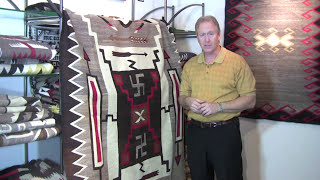Crystal
The Crystal Trading Post (established 1896; now closed) was located on the Navajo Reservation in far western New Mexico, high up in the Chuska Mountains. Due to its remote location, trading post proprietor J.B. Moore had to be resourceful to sell the Navajo rugs he purchased from the local weavers. He published a mail-order catalog in 1903 and 1911, selling Navajo rugs to people in the eastern United States. These catalogs would allow a buyer to choose specific designs and wool quality. Printed images of the rug designs - called plates - appeared in the catalogs, and the weavings that resulted from them are now known as plate rugs and are highly collectible. Plate #28 in the first catalog is the best-known plate rug, the storm pattern. Early Navajo Crystal rugs (1900-1910) often were made from natural brown hand-spun wool yarn and featured simple designs - an aesthetic that works well in today’s modern homes. Later Crystal rugs are reminiscent of Oriental rug patterns. They feature geometric motifs such as hooks, “waterbugs,” frets, and chevrons, as well as bright aniline-dyed wools - though Crystal rugs are still often woven in natural colors even today.
